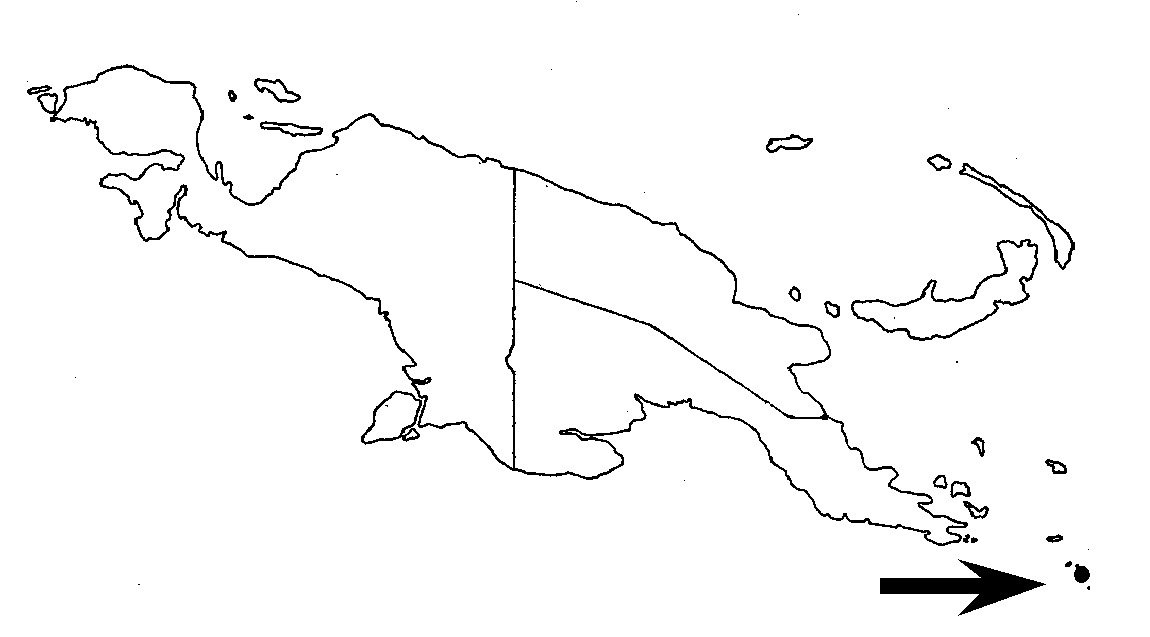
Distribution Map

Description (Barlow 1992)
Amyema brassii Barlow, Austral. J. Bot 22 (1974) 568. - Type: Brass 27827 (holo L 958,003492; iso CANB, K, LAB 31009), New Guinea, Sudest I., Mt. Riu, west slopes, 600 m, 25.viii. 1956.
For description see Barlow, Austral. J. Bot 22 (1974) 568. Amyema brassii can be identified by its combination of large opposite bifacial very shortly petiolate leaves, unusual umbels of tetrads with the outermost flower sessile and the lateral and innermost flowers shortly pedicellate, and shortly gamopetalous corolla. The flower colour is described as pink.
Amyema brassii is known only from Tagula I., Milne Bay
District, Papua New Guinea (fig. 3; 2 collections seen), at elevations
of 600 and 740 m. Habitat details and hosts are unknown. Because
of the shortly gamopetalous corollas and unusual floral tetrads,
the species is very distinctive in the genus, and with the related
A. tetraflora comprises a small satellite of the main field
of variation. See note under A. tetraflora.
Description (Barlow 1974)
Amyema brassii Barlow, sp. nov.
Type.-Papua, Sudest I., Mt. Riu, west slopes, 600 m alt., Brass 27827, 25.viii.1956 (L 958003492, holotype; CANB; LAE 31009; K).
Calyces, inflorescentiae et bracteae breviter
brunneo-tomentosi; corolla sparsissime albo-tomentosa; cetera
glabra. Caules teres, nodis incrassatis. Folia opposita; lamina
lanceolata, 12-20 cm longa, 3-6 cm lata, apice acuta acuminata,
margine recurva, supra nitida, subtus obscura, basi in petiolum
teretum 3 mm longum contracta, penninervis, costa distinctis.
Inflorescentiae in axillis singuli ortae, peduncu-latae, umbellatae;
umbellae c. 6-radiatae, radiis apice tetrafloris; pedunculus c.
6-radiatae, radiis apice tetrafloris; pedunculus c. 4 mm longus;
radii 3-4 mm longi; fore terminali tetradis sessili et floribus
lateralibus in pedicellis 1-2 mm longis positis; bracteae c. 3
mm longae, angustatae, acutae vel truncatae, erectae. Calyx leviter
infundibuliformis, 25 mm longus; limbus irregulariter dentatus,
0.7 mm longus. Corolla in alabastro maturo c. 35 mm longa, 6-mera,
leniter clavata, basi inflata; petalis in tubum 10-12 mm longus
cohaerentibus. Antherae 3 mm longae; partes liberus fllamentae
c. 9 mm longae. Fructus ignotus.
Glabrous except for the inflorescences, bracts and calyx shortly
brown-tomentose and the corolla very sparsely white-tomentose.
Stems terete, enlarged at the nodes.
Leaves opposite; petiole terete, 3 mm long; lamina lanceolate, 12-20 by 3-6 cm, shining above, dull below, contracted at the base, recurved at the margins, acuminate and acute at the apex; venation pennate with only the midrib prominent on both sides. Inflorescences solitary in the axils; peduncle c. 4 mm long; rays c. 6, 3-4 mm long; flowers in tetrads with the outermost one sessile and the two lateral ones and innermost one on pedicels 1-2 mm long; bracts c. 3 mm long, narrow, acute or truncate, occasionally with a weakly developed dorsal protuberance. Calyx 2.5 mm long, slightly funnel-shaped; limb 0.7 mm long, irregularly toothed. Corolla in the mature bud inflated at the base, weakly clavate at the apex, c. 35 mm long; petals in the open flower 6, coherent in the lower 10-12 mm. Anthers 3 mm long; free parts of the filaments 5 mm long. Fruit not seen.
Occurrence. Louisiade Archipelago (Sudest I.) (Fig. 2), 600 m altitude.
Specimen Examined. EASTERN NEW GUINEA: Sudest I., Mt. Riu, west slopes, 600 m alt., Brass 27827, 25.viii.1956 (L; CANB; LAE; K).
Among the species of Amyema in the
south-western Pacific, Amyema brassii shares with A.
tetraflorum the distinctive character of a gamopetalous corolla.
These two species are probably closely related, and differ in
that A. brassii is generally more slender and has a longer
inflorescence with three flowers in each tetrad pedicellate. Strongly
gamopetalous corollas also occur in a few Philippine species,
and during earlier revisional work on the Australian Loranthaceae
(Barlow 1966), I doubted whether these species could be retained
in Amyema. Having now examined the more diverse species
of New Guinea, I can find no additional differences between gamopetalous
and choripetalous species, and follow Danser (1931, 1935) in referring
them all to Amyema. There is a parallel situation in the
genus Psittacanthus in the New World. In Amyema, the
tetrad as an inflorescence unit is relatively rare, being recorded
in A. brassii, A. tetraflorurn and A. dilatipes in
the south-western Pacific, and in A. pendulumand
(occasionally) A. miquelii in Australia. The occurrence
of this character is not correlated with verticillate leaves in
Amyema, although a significant number of species in the
genus has verticillate leaves. The tetrad has probably been derived
from the triad independently in the Australian and New Guinean
stocks.
Illustrations
Photographs
Amyema brassii
updated 17 January 2007